Examples of Existing GDS Standards
Last updated on April 11, 2022
It is not necessary for a municipality to create a Green Development Standard from scratch. There are several other options:
- Require developers and builders to pick from a list of existing standards (eg: Halton Hills, Whitby, Toronto, etc)
- Modify an existing generic standard such as the one developed for the Federation of Canadian Municipalities by the Clean Air Partnership
The Federation of Canadian Municipalities and the Clean Air Partnership’s [1]Green Development Standard toolkit provides a detailed review of existing Green Development Standards in Ontario (page 54) and a framework to develop new plans (page 55).
Appendix A (page 103) has a Low Rise Residential development plan as well as a list of metrics which includes: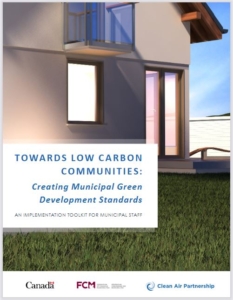
- Energy Efficiency
- Energy Management
- Pedestrian Infrastructure
- Green Buildings
- Tree Canopy
- Soil Quantity and Quality
- Natural Heritage
- Parks
- Storm water Management
- Solar Readiness
- Water Conservation
This Green Development Standard is directed towards urban centres and needs additional metrics for rural areas such as:
- Agricultural Nutrient Management
- Flood water protection
- Soil Erosion protection
The Green Development Standards can be incremental but it’s important to get started. An approach might be to allow builders to choose from an approved list of existing standards while a local GDS is being developed.
Municipalities with Green Development Standards
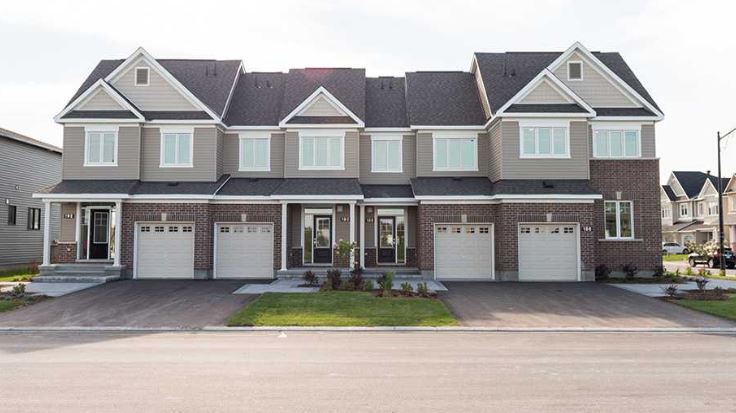
Green Development Standards have been developed and implemented in many communities, including several local municipalities.
- Federation of Canadian Municipalities [2]fcm.ca/en/resources/mcip/case-study-green-development-standards-growing-communities
- Mississauga [3]www.mississauga.ca/wp-content/uploads/2020/07/16135257/Green-Standards-Development-Standards-2012.pdf
- Municipality of Clarington [4]www.clarington.net/en/business-and-development/resources/Community-Planning-and-Studies/Secondary-Plans/Soper-Springs/Sustainability-and-Green-Principles-AODA.pdf
- Ottawa [5]engage.ottawa.ca/ottawa-high-performance-development-standard1
- Toronto [6]www.toronto.ca/city-government/planning-development/official-plan-guidelines/toronto-green-standard/toronto-green-standard-version-3/low-rise-residential-version-3/
- Vaughan [7]www.vaughan.ca/cityhall/environmental_sustainability/GreenDirections/General Documents/2019Green Directions Vaughan FINAL.pdf
- Whitby [8]www.whitby.ca/en/work/resources/Green-Standard/Whitby-Green-Standard-Reference-Guide.pdf
The Town of Halton Hills
The Town of Halton Hills is a leader in applying Green Development Standards to supplement the Ontario Building code.
- Halton Hills’ Green Development Information Guide can be found here: [9]www.haltonhills.ca/en/your-government/resources/Documents/GreenDevelopStandardsBrBooklet4print.pdf
- Halton Hills’ Green Development Standards Study – Final Report can be found here: [10]www.haltonhills.ca/en/business/resources/Documents/Green-Development-Standards-Study.pdf
- Halton Hills’ Green Development Standards Checklist can be found here: https://www.haltonhills.ca/en/your-government/resources/Documents/Green-Development-Standards-Checklist.pdfhttps://www.haltonhills.ca/en/your-government/resources/Documents/Green-Development-Standards-Checklist.pdf
Halton Hills – Checklist
The Checklist is a points-based system where the developer has to achieve a minimum number of points before a development application will be approved. The checklist is divided into 3 main sections: Low Rise Residential, Mid to High Rise, and Low Rise Non-Residential. The main sections are subdivided into different categories depending on the type of development.
Low Rise Residential: 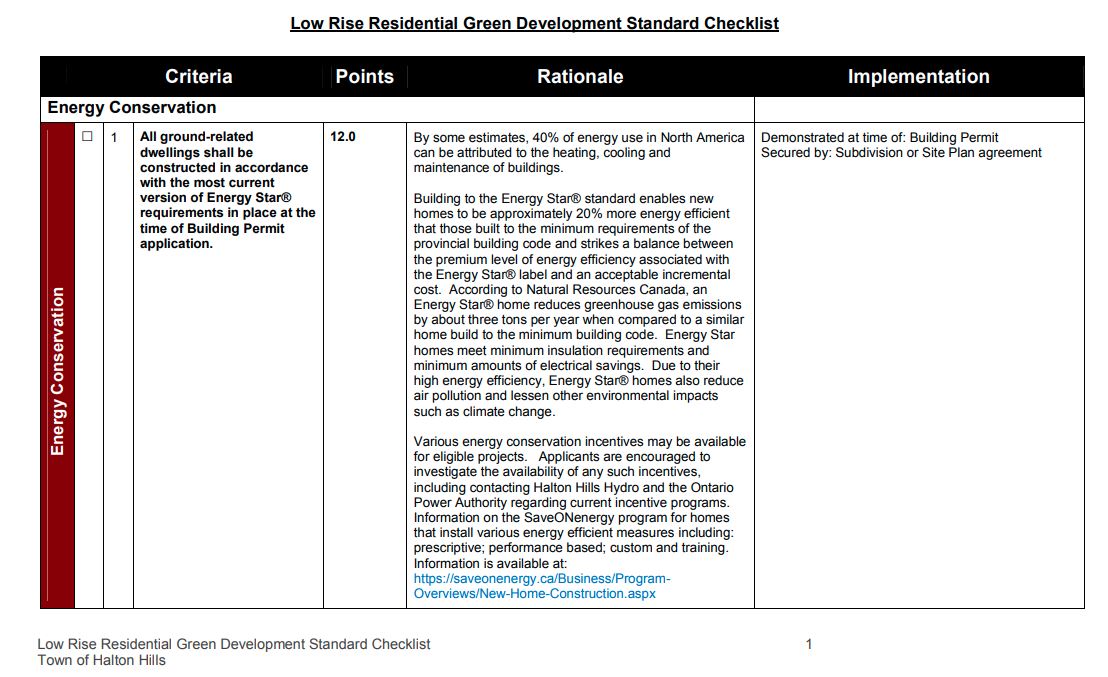
- Energy Conservation
- Water Conservation and Quality
- Community Design
- Air Quality
- Innovation & Green Features
- Waste Management
- Communications
Mid to High Rise: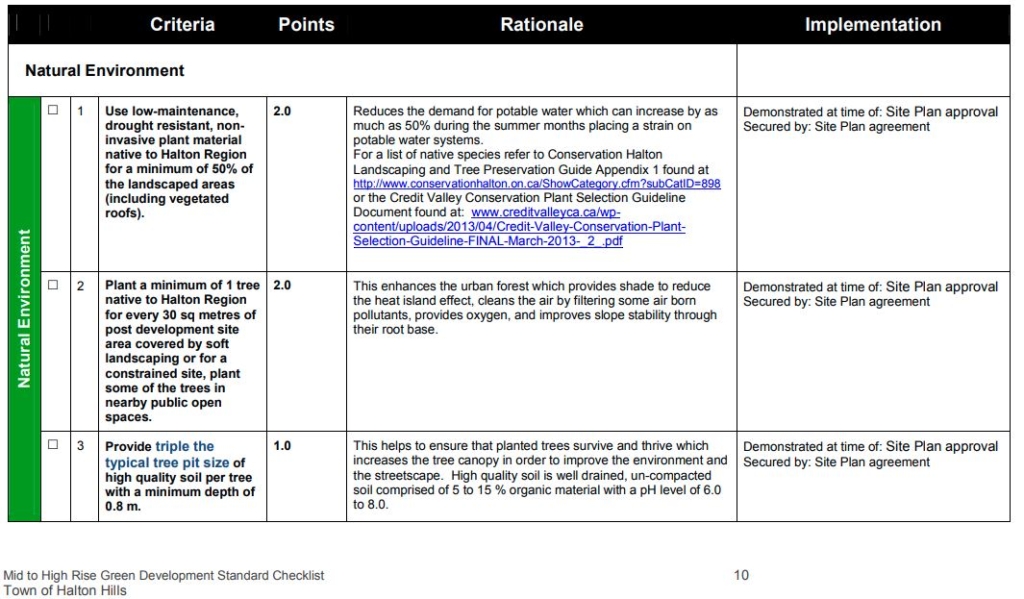
- Energy Conservation
- Water Conservation and Quality
- Transportation
- Air Quality
- Natural Environment
- Innovation & Green Features
- Waste Management
- Communications
Low Rise Non-Residential: 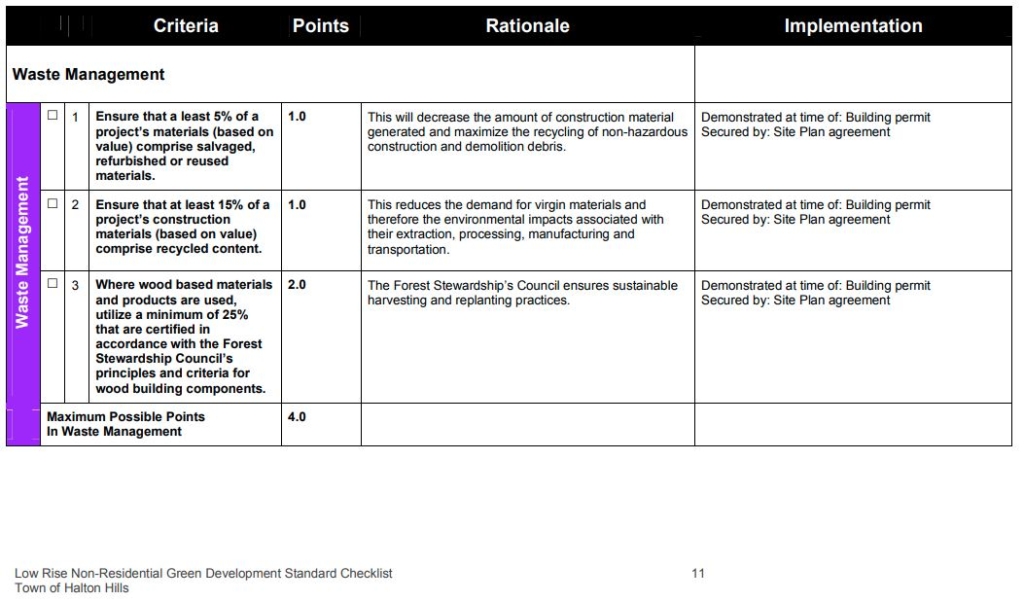
- Energy Conservation
- Water Conservation and Quality
- Transportation
- Air Quality
- Natural Environment
- Waste Management
- Innovation & Green Features
- Communications
These checklists were developed for the Town of Halton Hills and rural communities will have different criteria for green development. For example, for Community Design, a substantial number of points would be given for infilling and intensification in order to preserve farmland.
For More Information
Please see: Existing GDS.pdf
For the complete documentation package, please see the Documentation.pdf